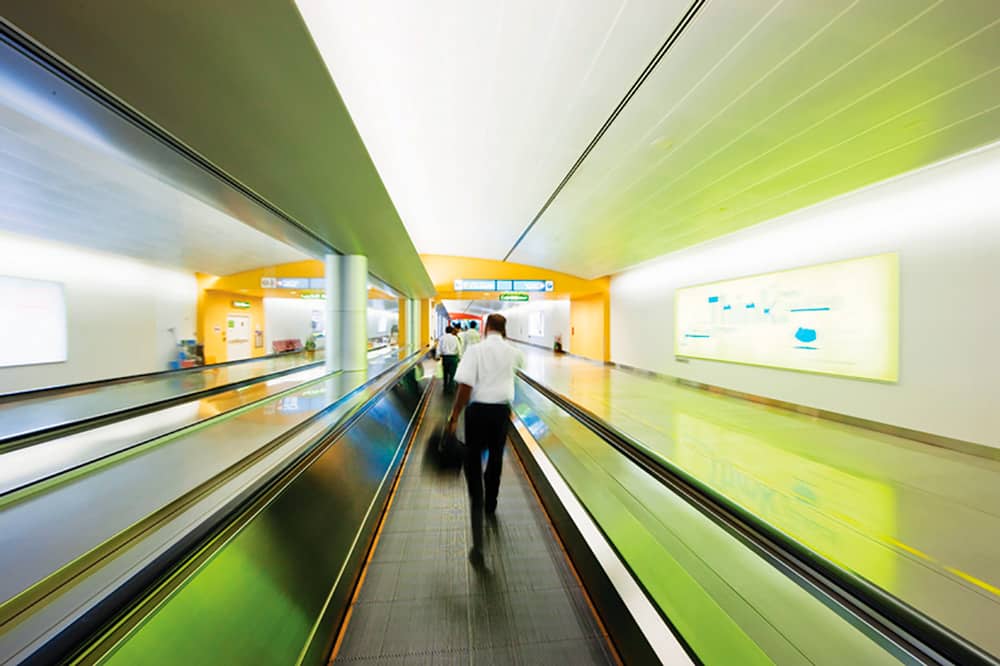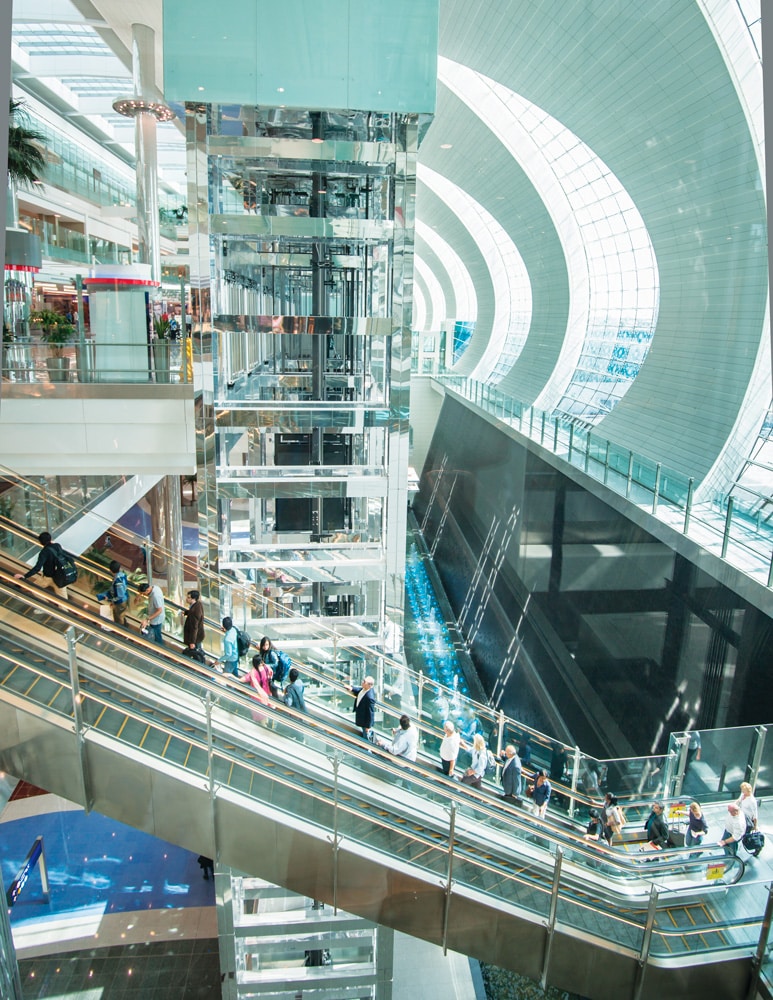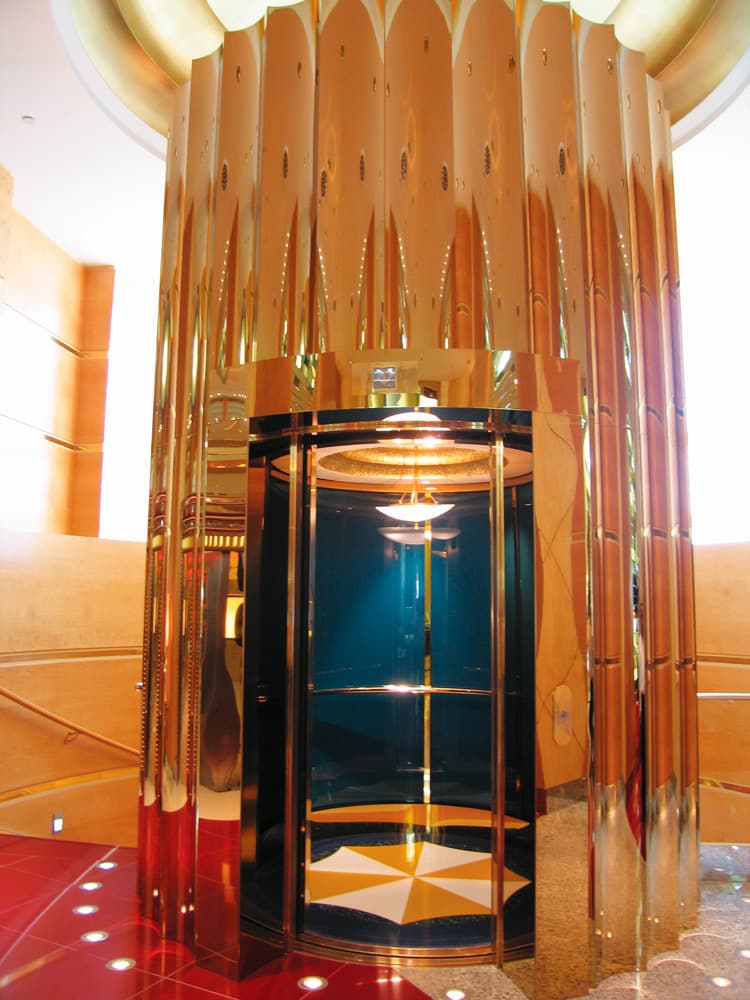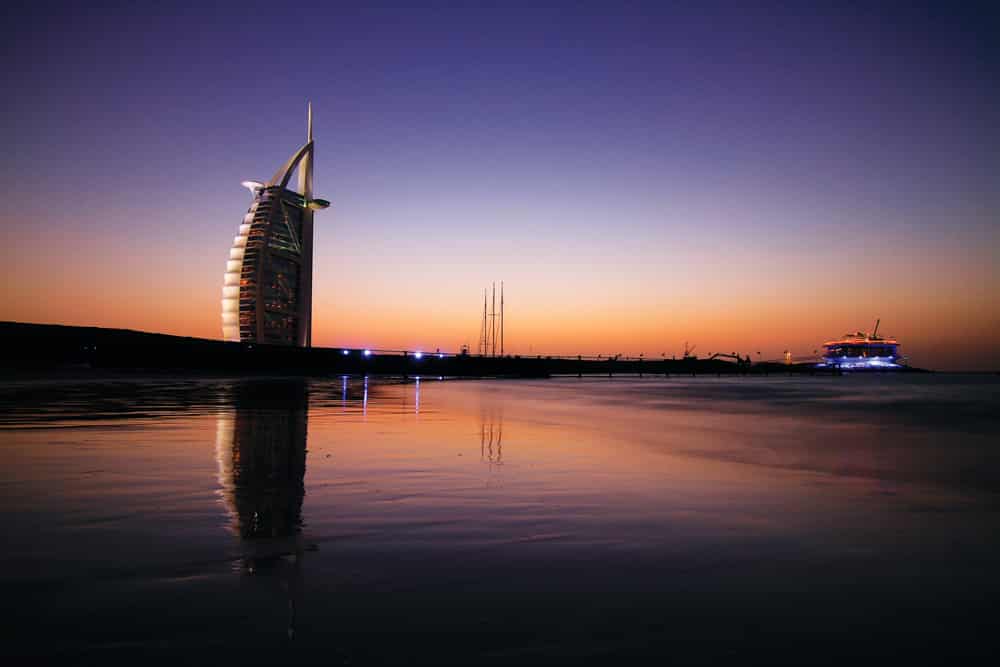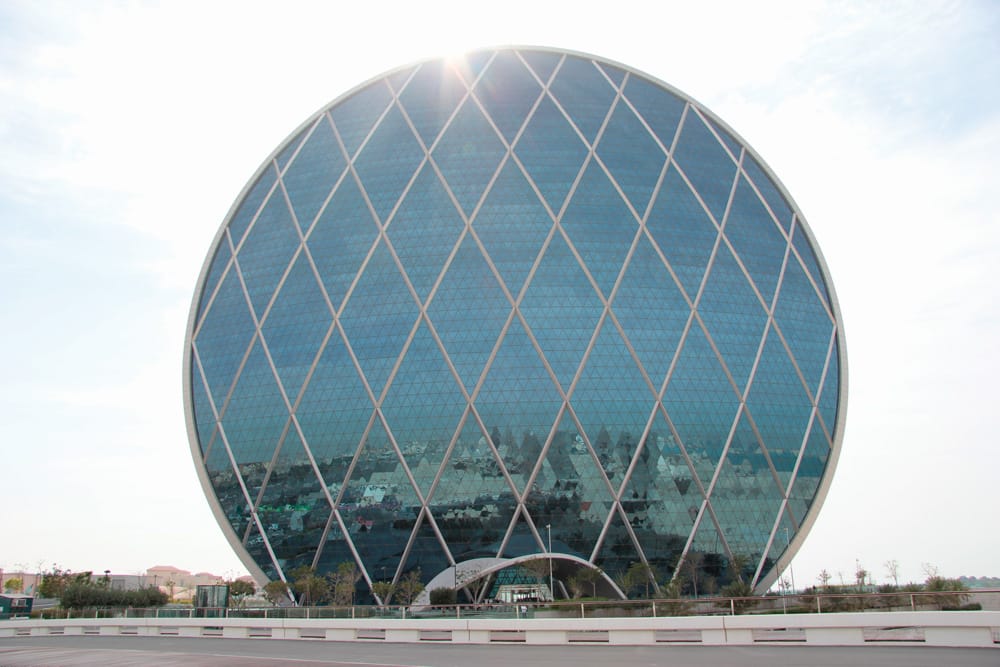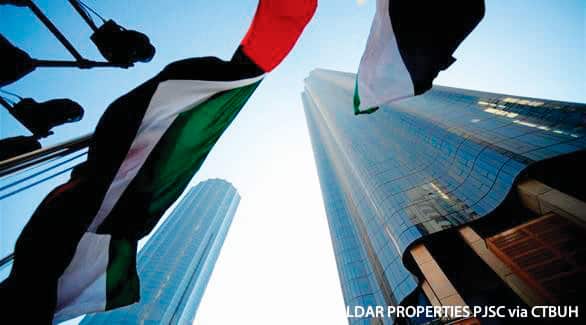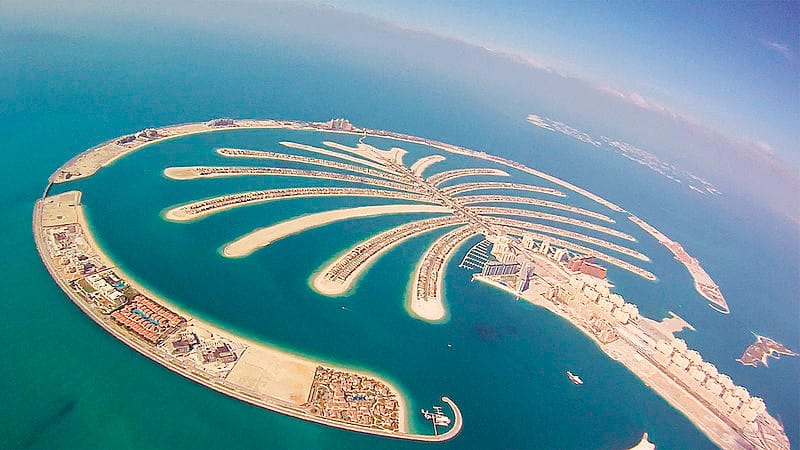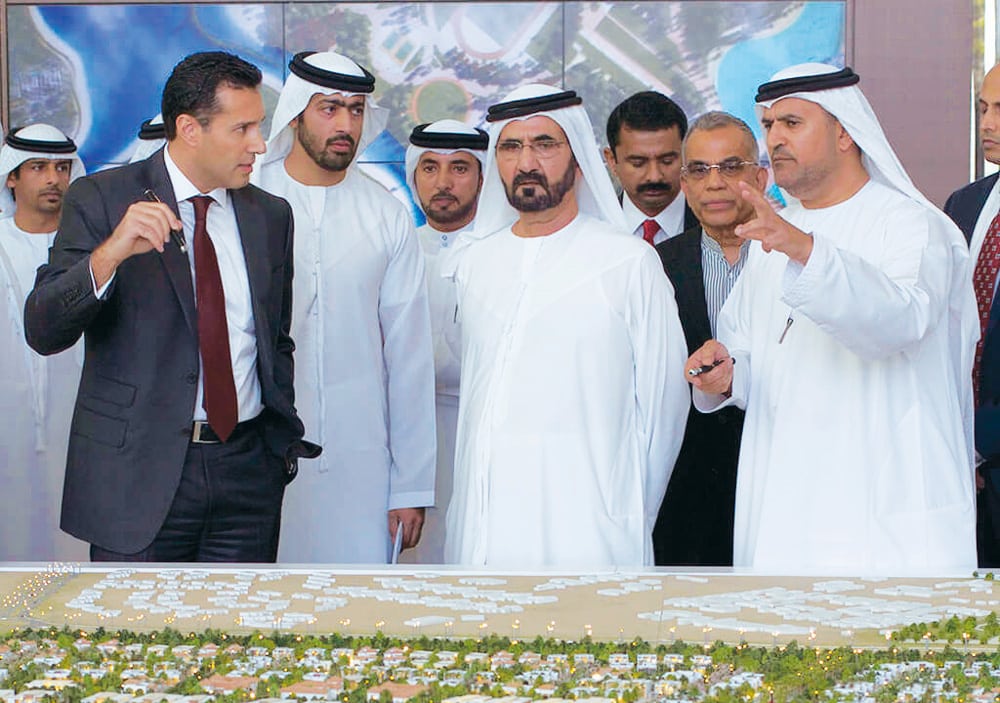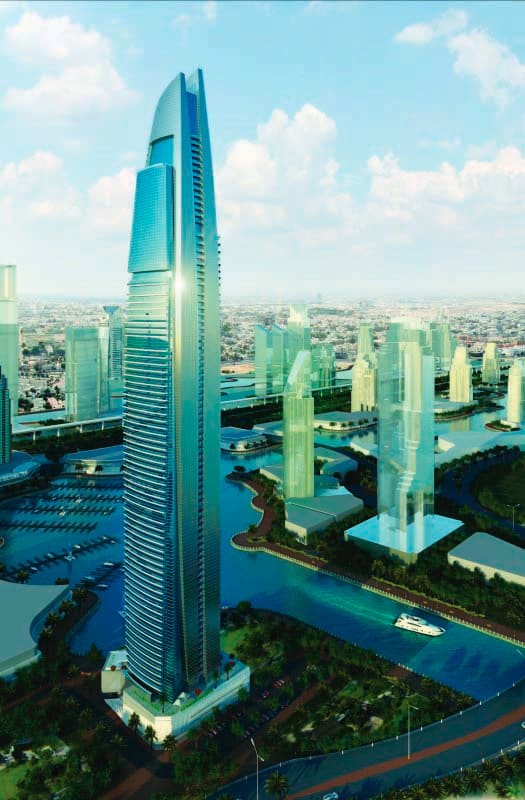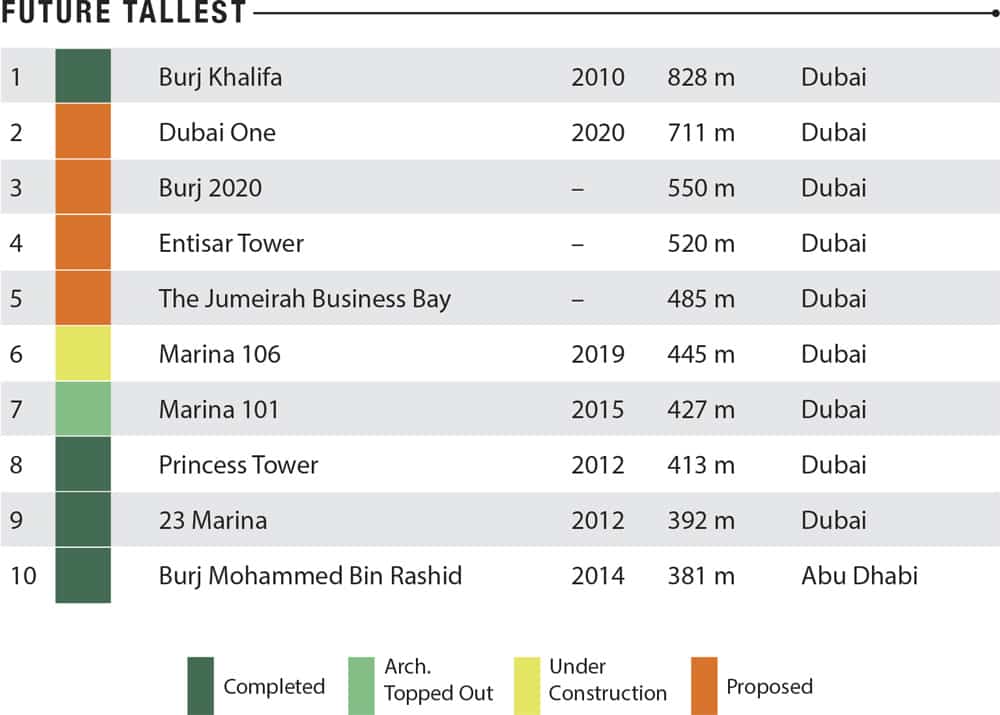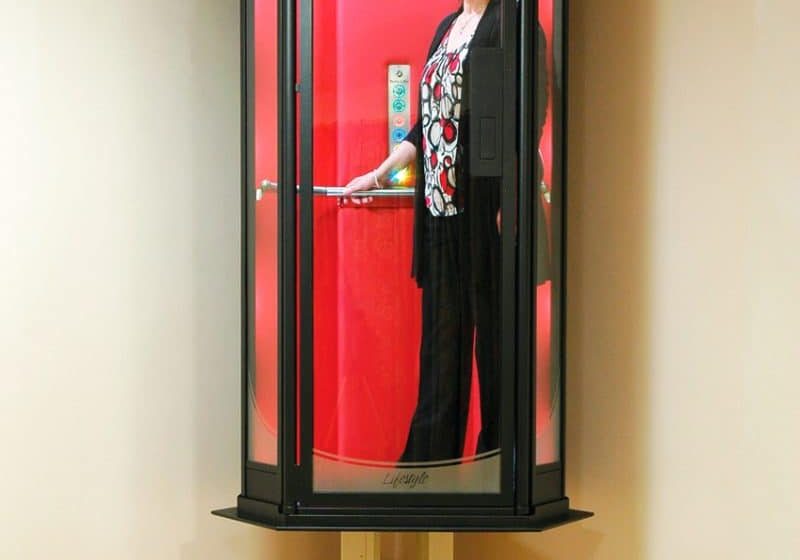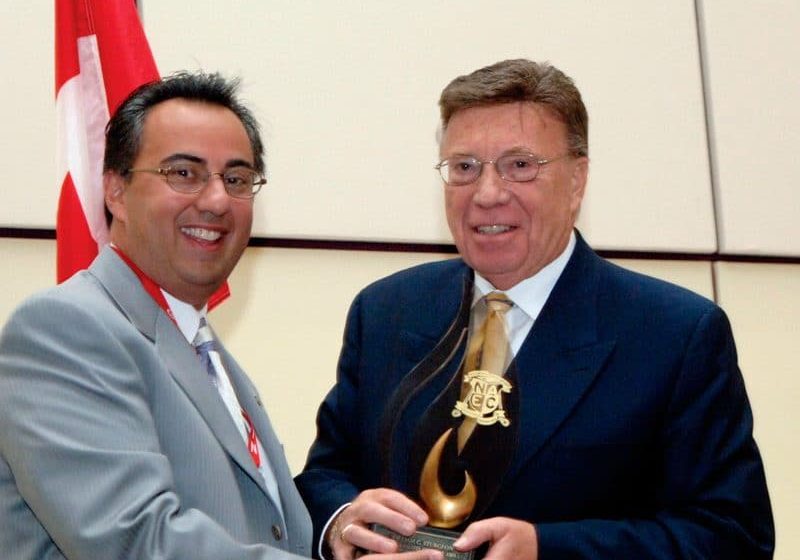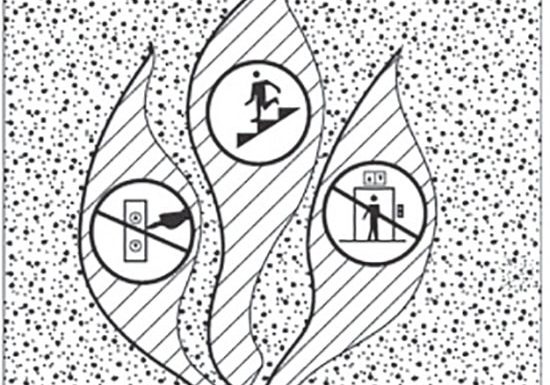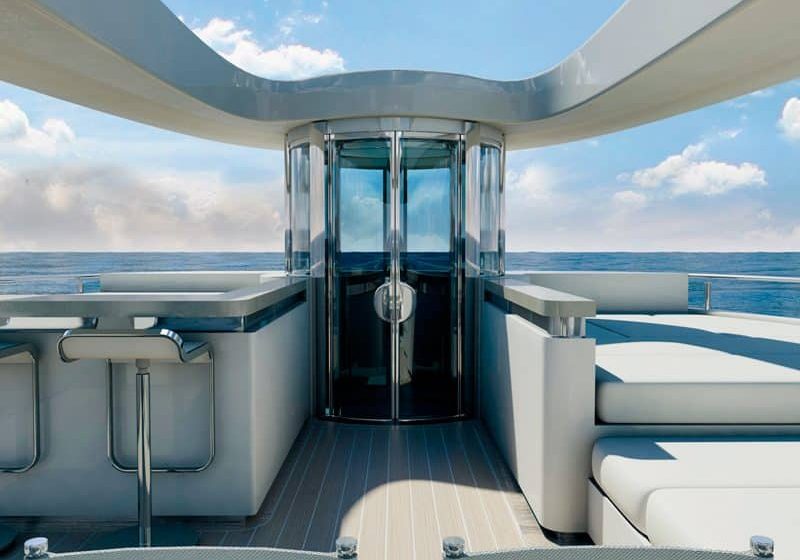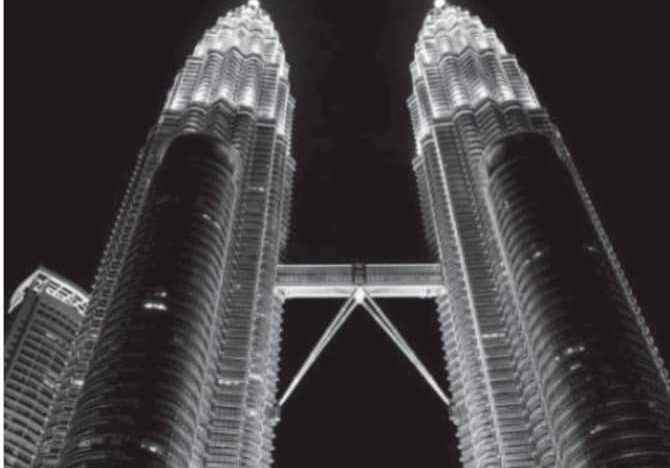Technology and style come together in one of the world’s most sophisticated vertical-transportation markets.
In tennis, there is a theory that rallying with a player far better than oneself will improve one’s game. Sometimes, this is true, as it drives the less skilled player to achieve feats he or she never thought possible.
The tennis analogy may be applied to the elevator industry in the U.A.E., where companies are “playing up” to fulfill developers’ ever-more-ambitious dreams. Competition is fierce here. When the world’s tallest building, the 828-m-tall Burj Khalifa in Dubai, was conceived in 2008, teams from the world’s biggest OEMs, such as KONE and Otis, got busy developing technologies for it, in the process bringing about a series of firsts: the first elevator to exceed 1 km in travel height, thanks to KONE’s new hoisting material UltraRopeTM (ELEVATOR WORLD, August 2013); and Otis’ fastest-ever double-deck elevator system with heat-resistant brakes made of advanced alloys – a feature that was necessary due to such weight descending at rapid speeds.
Mohamed J. Iqbal, EW correspondent and managing director of Toshiba Elevator Middle East LLC, states there are myriad reasons to be optimistic about the U.A.E. He says Toshiba Elevator’s business in the country is driven by high-rise hotel, residential and mixed-use projects; midrise hotel and residential buildings; and low-rise multifamily developments. He observes:
“In Dubai, we have seen major development of mid- to high-rise buildings in the Business Bay central business district, Dubai Marina and Palm Jumeirah (primarily known as New Dubai), whereas low-rise, community-living projects are taking shape in [mixed-use developments such as DUBAILAND®]. There are also clusters of mid- and low-rise projects off the new Al Maktoum International Airport and ‘logistics city’ taking shape there. Also, there is a major forecast for [the planned, mixed-use] development, Mohammed bin Rashid al Maktoum City.
“Development related to Expo 2020 in Dubai is also underway. In addition, the steady growth of Abu Dhabi projects in Saraya, the Abu Dhabi International Airport and Etihad Railway add to the list of milestone projects in the Middle East that [keeps] the real-estate market outlook positive. Recent announcements from Abu Dhabi city leaders about expansion of Al Reem Island, a parallel city alongside Abu Dhabi, are positive news for the real-estate industry.”
There is plenty of work to go around. Lerch Bates Inc., which handled vertical-transportation consulting on the Burj Khalifa, is working on more than 30 projects in the U.A.E. alone, observes Richard Roberts, general manager for the Middle East, Africa and Turkey. “Some of these will be additional landmarks for the ever-evolving Emirates,” Roberts states. Since opening its Dubai office in 2005, Lerch Bates has handled projects in a vast array of sectors including, but not limited to, healthcare, education and sports. Notable jobs include the 292-m-tall Sky Tower on Shams Island in Abu Dhabi, and the Atlantis Hotel and Emirates Palace hotel in Dubai and Abu Dhabi, respectively.
Cinderella Story
After the discovery of oil in what was then the Trucial States in the 1950s, the region underwent a remarkable transformation. Between Oman and Saudi Arabia and bordering the Gulf of Oman and the Persian Gulf, the U.A.E. was formed by the alliance of the Trucial States in 1971 after they gained independence from Great Britain.[1] Prior to the discovery of oil, it was impoverished, underdeveloped and reliant on the traditional industries of fishing and pearl diving.[1]
Side-by-side photos of Dubai from as recently as 1991 compared with today show starkly different cities – one dusty with a smattering of low-rise buildings, the other with a glittery Las Vegas-style skyline. Billions of U.S. dollars are being invested in manmade island “cities” off the coast and mixed-use developments that include elaborate water parks are in the works as the emirates continue to diversify beyond petroleum and attract more tourists and expatriates. The ritziest shops in the world can be found in here, along with one-of-a-kind destinations such as Ferrari World. The “world’s richest horse race,” the Dubai Cup, is held each year in March.[2]
An economy that has been, for the most part, thriving for decades hit some turbulence in 2008-2009 as the result of falling oil and real-estate prices combined with the international banking crisis.[1] But all indications are that the U.A.E. will be stronger than ever thanks to continuing efforts to expand its economy. As other nations in the region experience unrest, the U.A.E.’s relative stability holds even greater appeal as a safe, interesting tourist haven. Euromonitor International noted in its 2014 report, “Travel and Tourism in the United Arab Emirates”:
“Since the economic recovery of 2011, the government has reinvigorated its efforts to develop the tourism market as an alternative source of income for the country by intensifying its level of investment in developing infrastructure, as well as marketing and branding efforts at home and abroad to promote tourism. In particular, following the country’s winning the bid to host EXPO 2020, a number of important infrastructure projects are being [undertaken], including tourist attractions such as the Dubai Water Canal (a proposed mixed-use development that includes an astonishing 450 restaurants) or the plan to expand the Dubai International Airport to boost passenger capacity to 90 million by 2018.”
Iqbal says that to help ensure the real-estate sector continues to grow, the government has enacted measures to prevent a market bubble, keep out disreputable and inexperienced developers and safeguard investors’ money. “This instills confidence and boosts the market,” he says, noting there has been a steady announcement of projects since 2013. Major developers, he notes, include Aabar, Aldar, Damac, Dubai Properties, Omniyat, Danube, Emaar and Nakheel. The pace is expected to continue leading up to EXPO 2020, he says.
The U.A.E. has captivated the world’s attention as a place of promise and prosperity. Immigrants make up more than 80% of the population with a range of ethnic groups: 19% Emirati; 23% other Arab or Iranian, 50% South Asian and 8% other expatriates such as Westerners.[1] Since the economic recovery in 2011, the government has expanded its visa program to make it easier for doctors from elsewhere to work in the U.A.E. and for people seeking medical treatment to receive treatment there.[3]
A Desire for the Best
For such a small country, the U.A.E. has a disproportionately large number of iconic buildings. Beyond the Burj Khalifa, Iqbal points to the “exotic, pineapple and honeycomb design” of the Al Bahr Towers in Abu Dhabi, an Aedis-designed project that was recognized in 2012 by the Council on Tall Buildings and Urban Habitat (CTBUH) as a Best Tall Building finalist for the Middle East and Africa, as well as recipient of its Innovation Award. Emporis praised the towers for their “dynamic, translucent facade that runs off power generated by photovoltaic panels which react to sunlight.”
Accolades keep coming for U.A.E. buildings: in 2015, CTBUH deemed Burj Mohammed Bin Rashid Tower in Abu Dhabi, for which Otis did the elevators, the best tall building in the Middle East and Africa. CTBUH lists the qualities that earned the 381-m-tall, Foster+Partners-designed tower the honor:
“The Burj Mohammed Bin Rashid Tower is located in the heart of Abu Dhabi at the site of the old Central Market, a traditional crossroads and a meeting point in the city. A souk extends the marketplace into the building, facilitating a gentle transition between public and private spaces. A smooth, sleek and reflective façade is designed to require minimal amounts of maintenance in a dusty environment. Meanwhile, layers of internal shading control glare and unwanted heat gain. The exterior envelope of the tower undulates in waves as it wraps around the core. This glass cladding creates a mirage effect that alludes to its geographical context.”
Form and Function
Elevator systems in the U.A.E. must not only look good, they also must perform well, Iqbal notes. Environmental friendliness is important to customers, but appearance is no less so. “Lobby finishes and cabin interiors are major drivers in the U.A.E.,” he observes. “Interiors favored by consultants and contractors include, but are not limited to, etched patterns reflecting the intent or theme of the building and special materials such as bonded metals and paints.” As for performance, systems have features that alleviate the effects of wind sway or stop a unit at the nearest floor if seismic activity is detected. Destination dispatch is very popular.
Eduardo Montero, general manager of ThyssenKrupp Elevator U.A.E., observes the market has many players ready and willing to deliver. The market is extremely competitive, he says, observing:
“It is a battleground for both Western and Asian manufacturers/suppliers, where projects commonly require high-end specifications, as well as service, all in a fast-changing business environment. Also a challenge is the relatively high employee turnover among all companies doing business in the country, primarily due to the fact that the workforce is composed mostly of expatriates. Nevertheless, the rewards are also plentiful, such as playing an active role in the history and development of this country, taking part in some of the world’s most prestigious projects and working in a truly incomparable multicultural and diverse environment.”
The market is a busy one, and players must stay on their toes to earn a good living here, Iqbal says. As a link between Asia and the West, the U.A.E. draws top competitors from the U.S., Europe and the Far East, all bringing their latest technology to the table, he observes.
DAMAC Heights
DAMAC Heights is a luxury residential project with 12 5-mps elevators serving 91 stops. Overlooking manmade archipelago Palm Jumeirah, the tower boasts a selection of penthouses, duplexes, and three-, two- and one-bedroom apartments. Residents wake up to views of Palm Jumeirah. DAMAC Heights will become one of the tallest buildings in Dubai and the fourth-tallest residential building in the world, surpassed only by Pentominium (in Dubai), World One (in Mumbai) and Marina 101 (in Dubai).
Toshiba Elevator was awarded the elevator package for this project with the daunting challenge of completing the installation on a fast track, as it was necessary to hand over the elevators shortly after handover of the machine room. A project-management team handled all the engineering, design, manufacturing and installation activities and worked closely with the client, contractor and consultant. This resulted in the project being ahead of schedule.
The elevator system is divided into three zones – low, mid and high. The low zone is served by six 3-mps elevators serving 56 floors. The mid zone is served by three 4-mps elevators that travel from the ground floor to 17 stops higher than the low zone. The high zone is served by two passenger and one service elevator operating in a three-car group, traveling from the ground floor to 25 stops higher than the mid zone at a speed of 5 mps.
This project is the last high rise in the Dubai Marina district and stands adjacent to the Cayan Tower (EW, January 2014 and November 2011). – Mohamed J. Iqbal
Saraya Towers by Aabar
These are two striking, luxury residential towers with water views of the Abu Dhabi Corniche and the Saraya Lagoon. Situated at the tip of the impressive Saraya development, they complement each other. These adjacent 41- and 46-story towers have apartments on each floor. Podium decks provide extravagant landscaped areas with swimming pools. The buildings are enhanced by sky gardens, courtyards, terraces and landscaped rooftops. The façade is sculpted to catch and reflect different angles of the sun throughout the day.
Each tower is served by three passenger and one service elevator with speeds of 4 and 3 mps, respectively. Additionally, there is one penthouse elevator per tower. The units are designed with bronze, copper and stainless-steel interiors in a range of finishes. – Mohamed J. Iqbal
U.A.E. Facts
- Area: 83,600 km²
- Gross domestic product: US$269.82 billion (2013)
- 150-m-plus-tall buildings: 189 completed; 25 under construction
- 300-m-plus-tall buildings: 21 completed; 10 under construction
- Tallest city: Dubai
- Global ranking: Fourth in the world in terms of 150-m-plus-tall completed buildings
- Regional ranking: Number one in the Middle East in terms of 150-m-plus-tall completed buildings
- First 150-m-plus-tall building: Baynunah Hilton Tower Hotel (165 m, 1994)
- Average building age: Six years
- Most common function: Residential (50%)
- Most common material: Concrete (95%)
- Source: CTBUH
Acknowledgement
EW Correspondent Mohamed J. Iqbal
This page, top (l-r): ETA Melco cab in the Burj Al Arab hotel; an elevator as a work of art; ETA Melco unit in the Gold Center in Dubai
This page, bottom: Burj Mohammed bin Rashid, CTBUH’s Best Tall Building for South Africa and the Middle East for 2015
References
[1] BBC News, “United Arab Emirates Profile – Overview,” February 24, 2015.
[2] www.dubaiworldcup.com
[3] Euromonitor International, “Travel and Tourism in the United Arab Emirates, Executive Summary,” October 2014.
Get more of Elevator World. Sign up for our free e-newsletter.
